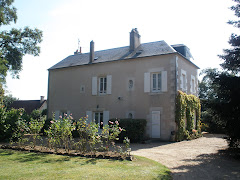



One of the most vivid way to understand the history of Nevers is by studying architecture and monuments. Nevers is a city that (barring the Roman era, from which we have only archeological remains and not architectural ones) was constructed in more or less three waves: the first, in the middle ages-renaissance with the Palais Ducal and Cathedral, the second, in the second half of the nineteenth century with Hausman-style bourgeois immeubles (apartment buildings), and the third, beginning after the second world war with more suburban-style individual houses. The contrasts between the architectural styles of these periods is quite stark, especially, once one is aware of them. The division between the quartiers (neighborhoods) is nette (neat, clear, distinct), and it's easy to tell when you're passing from one to the next.
The river traverses, and thus joins, the three kinds of quartiers. In Nevers, two ponts (bridges) represent the two more recent eras of development, the romantic period and the contemporary period. For what remains of the medieval period, however, one se demande (asks oneself) how people arrived in the town. Well, one of the tourist landmarks is the Porte de Croux (literally the door of Croux-- I still haven't been able to figure out exactly what this means). This "door" is a kind of entryway to the city with an arch. The tourist plaque in front of it explains that it was a symbol of welcome to the city. Of course, the plaque goes on to say that it was equipped with all of the latest defense mechanisms for the time period, including towers, arrow holes, and speared gates. The Porte de Croux is a complex of two arches, which, during the medieval period were separated by a moat, as far as I can understand from drawings I've seen. The first arch was meant to protect against military advancements such as boulets de fonte (melting cannonballs, what I imagine to be made out of still hot iron).
While the presence of these arches doesn't explain the problem of how to ford the river during the medieval period, it does serve to mark the beginning of the medieval quartier. Once you pass through, or next to, la Porte de Croux, you have no question as to where you are. Inside the ruins of the old remparts (ramparts, or city walls), you feel the 600 year-old history of the neighborhood, which, on by means of its slopped streets, leads to the top of the butte (hilltop) where the Cathédrale and Palais ducal dominate.
A walk along the remparts down to the river never fails to take me out of my present time, worries, and projects, even if only for the short instance it takes to notice the curious and perpetual shade of grey that colors the low-hanging sky and its ever-present clouds. The other day, while walking this route, I decided to read the little tourist placards I just mentioned. While glancing over them, I made a very happy discovery: the drawing of the two arches during the medieval period is accredited to one Charles Bossu! Recognize the name? It's the man after whom my street is named! I now have a stronger affinity for Général Bossu, and aspire to, like him, one day have a sketch of mine grace a tourist plaque, ensuring me a long legacy and eternal renown. I also am feeling more and more attached to this peculiar netherworld with its doom and gloom. Although I'm leaving tomorrow for a trip to the states, I'll be looking forward, in some inexplicable way, to retrouver (go back to) this dreamworld.



Thanks, Megan! Good post. Is the dessin de Charles Bossu of the Porte de Croux?
ReplyDelete